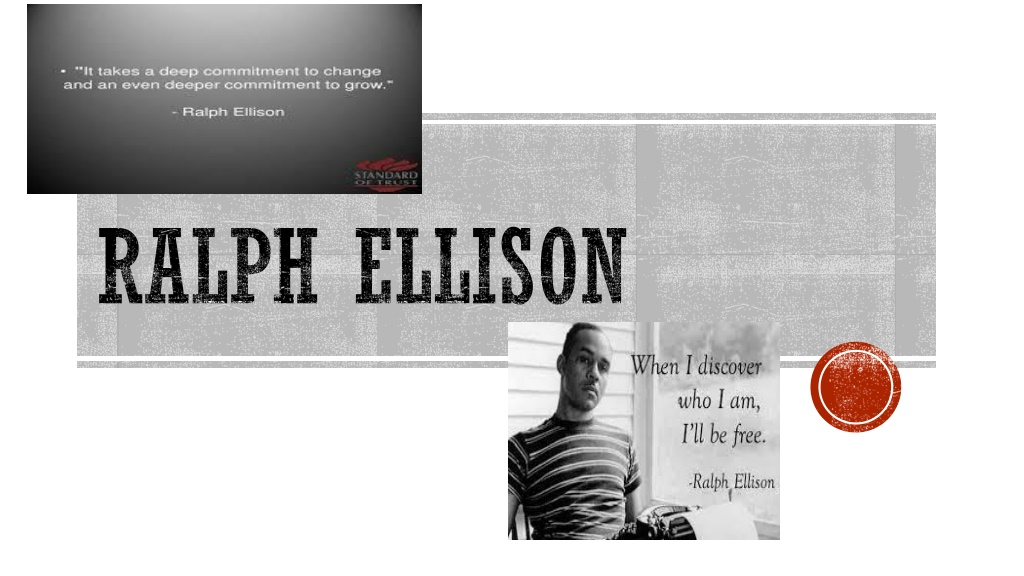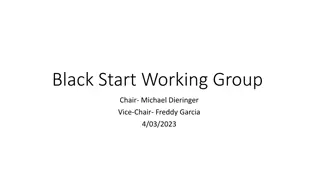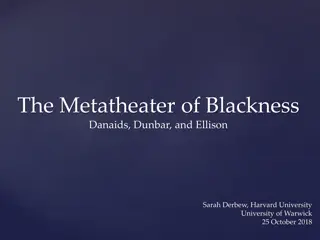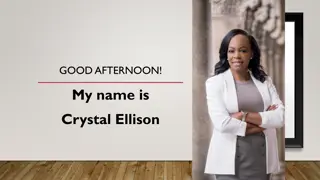Exploring Ralph Ellison's Invisible Man: Background, Historical Context, and Debate within the Black Community
Ralph Ellison, born in Oklahoma in 1914, authored the groundbreaking novel "Invisible Man" in 1952. The work delves into themes of identity, racism, and societal expectations. It is set against the backdrop of the Great Migration and features elements of Bildungsroman, Picaresque, and Existentialist genres. Ellison's narrative confronts the debate within the Black community regarding assimilation and resistance, echoing the ideologies of Booker T. Washington and W.E.B. DuBois. This exploration sheds light on the struggles and growth of the protagonist amidst a racist society.
Download Presentation

Please find below an Image/Link to download the presentation.
The content on the website is provided AS IS for your information and personal use only. It may not be sold, licensed, or shared on other websites without obtaining consent from the author. Download presentation by click this link. If you encounter any issues during the download, it is possible that the publisher has removed the file from their server.
E N D
Presentation Transcript
BACKGROUND INFORMATION ON THE AUTHOR Ralph Waldo Ellison was born on March 1, 1914, in Oklahoma City, Oklahoma He was named after the author Ralph Waldo Emerson His father was a coal deliverer and died in a work related accident when he was three years old He attended Tuskegee Institute in Alabama in 1933 on a scholarship When he first attended the school he was going to become a music composer In 1936 he left in his junior year and went to New York and he meet the author Richard Wright who became his mentor During WW II he worked as a cook in the Merchant Marines He began working on his masterpiece Invisible Man when WW II ended Invisible Man was published in 1952 and won the National Book Award in 1953 He was awarded the Presidential Award of Freedom in 1969 He was a professor at New York University from 1970 1979 Ralph Ellison died in 1994 of pancreatic cancer
HISTORICAL INFORMATION Complete novel published in 1952 Great Migration Booker T. Washington (education=equality) W.E.B. Dubois (openly fight for rights/career) Marcus Garvey ( Back to Africa movement) Existentialism (sought to define the meaning of individual existence in a seemingly meaningless universe)
DEBATE WITHIN THE BLACK COMMUNITY Booker T. Washington Assimilation Manual Labor Blacks must learn to live within the racist order of the South W.E.B. DuBois Criticized Washington for what he viewed as giving in and submitting to the white culture Blacks must resist the racist order of the South
CHARACTERISTICS OF THE GENRE Bildungsroman - individual s growth and development within the context of a defined social order Picaresque - satirical account of a rogue s progress through society Existentialist novel -philosophical system concerned with free will, choice, and personal responsibility African-American fiction Social protest
PLOT SUMMARY Ralph Ellison's Invisible Man is a first-person novel containing an unnamed narrator who comes from a poor family from the South. The narrator is haunted by his grandfather's deathbed warning against conforming to the wishes of white people because the young man sees that as the way to be successful. One bizarre night, he ends up with a scholarship to a black college, but his misadventures leave him penniless and alone in Harlem. His college president, first employer, and leaders of a political movement all conspire to use and abuse him in ways that range from ridiculous to cruel. However, the narrator manages to emerge strengthened through the process and determined to fight for racial equality.
STRUCTURE OF THE NOVEL Retreat Beginning Prologue Battle Royal College New York Harlem The Brotherhood Retreat End Epilogue
THE PROLOGUE PART 1 Setting: Basement in NYC Point of view/narration: Retrospective 1stperson, IM (elder) is the narrator Dialogue & diction/syntax & tone: Diction is sophisticated yet crude, reflects IM s education and background Syntax mimics spoken language Overall tone: sardonic and somewhat insane Character introduced: IM Distinction between IM (character) and IM (narrator)
THE PROLOGUE PART 2 Symbols/motifs: 1369 light bulbs Light & darkness The blues Being never quite on the beat Hallucinations Story of black woman shows ambivalence of black-white relationships Foreshadowing: Several prominent characters later in life of IM (character) mentioned IM (narrator) himself shows what IM (character) will end up like
CHAPTER 1: BATTLE ROYAL PART 1 Setting: After high school graduation, ballroom of a hotel IM (character) becomes the main narrator His behavior around whites signifies his naivety IM (narrator) makes comments at beginning and end of chapter showing how much he s changed Dialogue & diction/syntax & tone: Major difference between the voices of IM (character) and IM (narrator): IM (character) merely states things, doesn t analyze or doubt them, IM (narrator) is more experienced and jaded, ironically humorous Allusions: Booker T Washington Atlanta Compromise Emancipation Proclamation Symbols/motifs: Black & white sexuality Electricity Whites causing conflict between blacks Briefcase To whom it may concern: keep this nigger-boy running
CHAPTER 1: BATTLE ROYAL PART 2 Imagery: The fighters are described like animals, sub-human Foreshadowing: The grandfather s last words IM (narrator) hinting that IM (character) doesn t understand his situation yet Irony: Situational: whites trying to mold blacks into stereotypical promiscuous beasts yet trying to stop them from touching their women Dramatic: IM (character) doesn t realize he s being played by the whites Verbal: IM (narrator) knows what will happen later
CHAPTERS 2 3 NORTON & THE GOLDEN DAY PART 1 Setting: The college, Trueblood s shack, the Golden Day Characters introduced: Mr. Norton & Jim Trueblood Supercargo The veteran Dialogue & diction/syntax & tone: Words and structure mimic spoken language and reflect education level Obvious difference between Trueblood and Norton IM (narrator) uses repetition of sentence structure when describing the college, shows nostalgia Allusions: Historical figures: Ralph Waldo Emerson, John D. Rockefeller, Thomas Jefferson Bible Freudian psychology
CHAPTERS 2-3 NORTON & THE GOLDEN DAY PART 2 Symbols/motifs: Whitewashed walls of the college White dividing line on the highway Birds Bird-soiled statue of the Founder Imagery : Description of the college is very idyllic Flashback: Trueblood recalls impregnating his own daughter Foreshadowing: IM (narrator) describes the past using things that happen later in his life Irony : Situational: Trueblood s situation and the reactions of blacks and white
CHAPTERS 4-6: RETURN & EXILE FROM THE COLLEGE 1 Setting: The college church, Bledsoe s office Characters introduced: Homer A. Barbee Dr. Bledsoe Dialogue & diction/syntax & tone: Barbee s speech is very sophisticated, but flat: it doesn t really emotionally impact the reader Bledsoe s words are those of a white man, use of nigger IM (narrator) uses long, descriptive sentences when remembering details Allusions: Tuskegee Institute Puritans Homer Horatio Alger Jim Crow laws & segregation on buses
CHAPTERS 4-6: RETURN & EXILE FROM THE COLLEGE 2 Symbols/motifs: Blindness Bledsoe s shackle Cage (that Bledsoe makes with his fingers) Foreshadowing: IM (character) will continue to be used by whites and lose parts of himself until he is no longer blind The vet s words to IM (character) and Norton Irony : Situational: Bledsoe is not trying to help blacks, he s the one manipulating the whites
CHAPTERS 7 9 TRIP & ARRIVAL IN NYC PART 1 Setting: Bus, subway, North, NYC, Harlem, Men s House, Emerson s office Characters introduced: Peter Wheatstraw & Emerson s son Dialogue & diction/syntax & tone: Emerson s son uses negative words to express discord with his father and suggestive words when talking to IM (character) Allusions: Pete Wheatstraw, the blues Ralph Waldo Emerson Huckleberry Finn Jack the rabbit The story of Jonah (from the Old Testament)
CHAPTERS 7-9: TRIP & ARRIVAL IN NYC PART 2 Symbols/motifs: Journey north Red apple 7 Letters Birds & cages Stereotypical southern food Imagery: Ras first impression on IM (character) is very vivid, he s angry and passionate Foreshadowing: IM (character) dreams of his grandfather and feels like he s being deceived and used by someone like Bledsoe or Norton Emerson s son says that no one has any identity Epiphany : IM (character) realizes that Bledsoe had tricked him, becomes thoroughly disillusioned with the college
CHAPTERS 10-11: LIBERTY PAINTS PART 1 Setting: Liberty Paints factory, factory hospital Characters introduced: Kimbro Lucius Brockway Dialogue & diction/syntax & tone: Capitalization in Brockway s words expresses anger Doctors question IM (character) with capitalized signs, dehumanize him Symbols/motifs: Liberty Paints factory 10 drops of black paint into white paint Black and white imagery Machinery/technology Electricity Castration & black and white sexuality Hallucinations
CHAPTERS 10-11: LIBERTY PAINTS PART 2 Imagery : IM (character) goes through rebirth at the hospital, images of birthing mothers & becoming a new person Allusions: Labor unions Electroshock therapy Brer Rabbit Irony Situational: black paint is needed to make white paint whiter Situational: after IM (character) adds the correct black paint to the white paint, he can still see the gray tinge even though Kimbro can t Situational: the one behind the success of the white paint is an uneducated, poorly paid old black man Epiphany: IM (character) is forced to acknowledge his past and heritage IM loses his job at Liberty Paints, thereby losing his last connection with the college, becomes a new person
CHAPTERS 12-13: MARY & THE EVICTION PART 1 Setting: Men s House, Mary s apartment, old couple s apartment, caf Characters introduced: Mary Rambo Brother Jack Dialogue & diction/syntax & tone: Starts with long, fragmented sentences, mirror his state of mind after therapy IM (narrator) uses a sarcastic & bitter tone when describing blacks who resemble IM (character) of the past Repetition of words related to hot & cold Repetition of law-abiding people in eviction speech Allusions: Everything the old couple had Historical heroes : Jefferson, Jackson, Pulaski, Garibaldi, Booker T. Washington, Sun Yat-sen, Danny O Connell, Lincoln
CHAPTERS 12-13: MARY & THE EVICTION PART 2 Symbols/motifs: Sweet yams Food in general Black & white images Cheesecake and coffee Imagery: Old couple s possessions show the story of blacks pre, during, and post-Civil War Foreshadowing: The second yam was rotten, indicates that IM (character) s new philosophy will break IM (character) does not enjoy the cheesecake that Brother Jack forces on him Irony : Situational: eviction speech meant to calm the onlookers down, instead riled them up even more Epiphany : Eating the yam causes IM (character) to embrace the freedom in making his own choices for his own wants
CHAPTERS 14-15: THE BROTHERHOOD PART 1 Setting: The Chthonian , Mary s apartment, Brotherhood apartment Characters introduced: Emma Dialogue & diction/syntax & tone: Characters are described by IM (narrator) in a mysterious and distrusting tone, foreshadowing how they later become IM (character) s enemies Allusions: Chthonian Symbols/motifs: Cabbage Sambo coin bank Cockroaches IM (character) s new name
CHAPTERS 16-17: FIRST BROTHERHOOD SPEECH & RAS 1 Setting: Arena where IM (character) gives the speech, Brotherhood apartment, 4 months pass, Harlem Characters introduced: Brother Wrestrum Brother Hambro Brother Tarp Ras the Exhorter Brother Tod Clifton Dialogue & diction/syntax & tone: IM (character) s speech had a passionate tone and was moving for the audience Repetition of brother to make the audience feel closer Allusions: Hoovervilles John Brown The blind leading the blind Nijinski Frederick Douglass
CHAPTERS 16-17: FIRST BROTHERHOOD SPEECH & RAS 2 Symbols/motifs: White lines Blindness CHECKS CASHED HERE sign Imagery: Baseball imagery during speech Clifton is described as the ideal black man Foreshadowing: Clifton accidentally hurts a Brotherhood member during a fight Tod is death in German Irony: Situational & dramatic: Ras wants black people to work together against the whites, he s actually being manipulated by whites too
CHAPTERS 18-19: NAMELESS NOTE & WOMAN QUESTION Setting: The Brotherhood s office in Harlem, woman question conference, nameless woman s apartment Characters introduced: Nameless woman Symbols/motifs: Anonymous note Leg chain Black & white sexuality Imagery: Suggestive imagery associated with the woman, emphasizing the social class difference Flashback: Tarp recalling his story of freedom Foreshadowing: The anonymous note telling IM (character) not to go too fast or the Brotherhood will reject him Clifton has gone missing Irony : Situational: Wrestrum accuses IM (character) of using the Brotherhood to get famous, in reality it s the other way around The woman who supposedly advocated women s rights was used to seduce IM (character) Epiphany: IM (character) realizes that the Brotherhood is racist in its own way
CHAPTERS 20-21: CLIFTONS DEATH AND FUNERAL 1 Setting: Barrelhouse s Jolly Dollar, 125thstreet, Mount Morris Park Dialogue & diction/syntax & tone: Language used in Sambo scene is mocking of black slave culture, use of music/verse Repetition of his name was Clifton Repetition of comic-book Voice expresses bitterness and grudge; IM (character) really felt that Clifton was a friend, feels betrayed Allusions: Sambo Symbols/motifs: Paper Sambo dolls Clifton s death Imagery: The doll s appearance and motions are insulting and infuriating to IM (character), self-mocking image of Clifton Clifton s death is described with religious imagery Black nun in white & white nun in black
CHAPTERS 20-21: CLIFTONS DEATH AND FUNERAL 2 Foreshadowing: The community s hatred of the Brotherhood Tarp is gone as well Clifton s descent into invisibility/underground IM (character) feels the tension still present in Harlem Irony: Situational: Clifton left the Brotherhood after he became disillusioned; IM (character) used his death as a marketing scheme to redeem the Brotherhood in Harlem Dramatic: IM (character) still doesn t understand that the Brotherhood is only using him; he s actually trying to improve the Brotherhood Epiphany: IM (character) realizes that people like Clifton will be forgotten by history and he doesn t want that to happen
CHAPTERS 22-24: RETURN TO HARLEM & RINEHART 1 Setting: Brotherhood committee room, bar Characters introduced: Brother Tobitt Rinehart Sybil Dialogue & diction/syntax & tone: Brother Jack uses a patronizing tone when talking to IM (character) When IM (character) and Brother Jack fundamentally disagree on how Clifton s situation should have been dealt with, Brother Jack becomes Jack , signifies the loss of trust & camaraderie Allusions: God Brutus Christmas night & Santa Claus Symbols/motifs: Red Brother Jack s glass eye Rinehart disguise (esp. the dark green glasses)
CHAPTERS 22-24: RETURN TO HARLEM & RINEHART 2 Flashback: Dreams of the grandfather Foreshadowing: Rinehart s personas are all stereotypical black roles Irony: Jack advises IM (character) to not lose his temper right after he yelled at IM (character) Hambro tells IM (character) that he needs to sacrifice Epiphany: IM (character) realizes that Jack has been half blind the entire time IM (character) finally sees invisibility as a solution and escape
CHAPTER 25: RIOT PART 1 Setting: Streets of Harlem Characters introduced: Dupre & Scofield Dialogue & diction/syntax & tone: Erratic syntax after IM (character) falls in manhole, mirrors state of mind Allusions: Harlem Riot of 1935 Uncle Tom s Cabin Marcus Garvey Symbols/motifs: White mannequins Burning of the tenement Manhole Briefcase & documents Fire
CHAPTER 25: RIOT PART 2 Imagery: Differences in description of Ras from pov of IM (character) and other bystanders IM (character) falls into the manhole (darkness) Flashback: Riot reminds IM (character) of the Battle Royal: white men forcing black men to fight Irony: Situational: IM (character) finally followed grandfather s advice, backfired Epiphany: Revealed that Jack wrote the anonymous note IM (character) realizes that he was being played by the Brotherhood all along By burning the documents, IM (narrator) cuts ties with his past once and for all, he is fully aware of the white man s manipulation
EPILOGUE Setting IM s basement, subway Point-of-view/narration: Narration is firmly in the hands of IM (narrator) again Voice is more positive than in the prologue IM (narrator) is still in the process of defining himself and thinking about his future Characterization: IM (narrator) is much more optimistic than in the Prologue Indicates that telling his story is cleansing Dialogue & diction/syntax & tone: Juxtaposition of chaos & order, underground & within society, invisibility & contributing to humanity Tone is not as dark, more reflective and progressive
EPILOGUE PART 2 Symbols/motifs: IM (narrator) recalls many that appeared in the Prologue and within the story Epiphany: IM (narrator) rejects the messages of both his grandfather and the veteran IM s infinite possibilities are a hyperbole of the freedom of speech from the Prologue IM (narrator) realizes that invisibility like Rinehart s is not desired, he needs to go back above ground and play an active role in society in order to become truly visible Life is to be lived, not controlled; and humanity is won by continuing to play in face of certain defeat (577).
CHARACTERS Narrator- unnamed protagonist/Prizefighter/Hero Mr. Norton- The College Trustee /Benefactor Jim Trueblood-Incestuous Sharecropper/The True Brother Dr. Bledsoe- College President/The Sellout Rev. Homer Barbee-Speaker at the last chapel/Blind Orator Lucius Brockway-Supervisor at Liberty Paints/The Sellout Mary Rambo-takes the narrator into her home/The Mother
CHARACTERS CONTINUED Brother Jack-recruits the narrator into the Brotherhood/The White Liberal Brother Tarp-gives narrator the ankle chain/The true Brother Ras the Exhorter-African Nationalist/Orator Tod Clifton-Brotherhood member who was killed resisting arrest/The Prizefighter Sybil-crazy woman who uses a rape fantasy to seduce the narrator/The Taboo White Woman The Grandfather-The Ancestor (represents the past) Rinehart-The Trickster (represents a new survival strategy for the future)
LITERARY DEVICES Motifs: Blindness Invisibility Dreams Violence Sex Oratory Music Power Family Symbols: black Sambo doll, the coin bank, Liberty Paint, the Brotherhood, briefcase, the road to asylum Similes (p.21): like a baby or a drunken man, like drunken dancers, like blind, cautious crabs Imagery : Chapter 1 the fight ( blind cautious crabs ) Chapter 2 description of the landscape and school campus Hyperbole: Chapter 3 Scene at the Golden Day Irony: Keep America Pure with Liberty Paints If It s Optic White, It s the Right White Personification (p.536) street s signs were dead
LITERARY DEVICES CONTINUED Juxtaposition: is a literary technique in which two or more ideas, places, characters and their actions are placed side by side in a narrative or a poem for the purpose of developing comparisons and contrasts. Chapter 2 - conversation (Norton, Trueblood, IM) Anaphora: is the repetition of a certain word or phrase at the beginning of successive lines of writing or speech. It can be used in novels and short stories, but it's most commonly seen in poetry, essays, and formal speeches Chapter 7 - The vet s advice to the narrator Play the game Polysyndeton: is a stylistic device in which several coordinating conjunctions are used in succession in order to achieve an artistic effect. (Epilogue)-- take [himself] by the throat and choke [himself] until [his] eyes bulged and [his] tongue hung out and wagged
SYMBOLS/ THE SAMBO DOLL AND THE COIN BANK The coin bank in the shape of the grinning black man (Chapter Fifteen) and Tod Clifton's dancing Sambo doll (Chapter Twenty) serve similar purposes in the novel, each representing degrading black stereotypes and the damaging power of prejudice. The coin bank, which portrays a grinning slave that eats coins, embodies the idea of the good slave who fawns over white men for trivial rewards. This stereotype literally follows the narrator, for even after he has smashed the bank and attempted to discard the pieces, various characters return to him the paper in which the pieces are wrapped. Additionally, the statue's hasty swallowing of coins mirrors the behavior of the black youths in the battle royal of Chapter One, as they scramble to collect the coins on the electrified carpet, reinforcing the white stereotype of blacks as servile and humble.
SYMBOLS/SAMBO DOLL AND THE COIN BANK The Sambo doll is made in the image of the Sambo slave, who, according to white stereotype, acts lazy yet obsequious. Moreover, as a dancing doll, it represents the negative stereotype of the black entertainer who laughs and sings for whites. While the coin bank illustrates the power of stereotype to follow a person in his or her every movement, the Sambo doll illustrates stereotype's power to control a person's movements altogether. Stereotype and prejudice, like the invisible strings by which the doll is made to move, often determine and manipulate the range of action of which a person is capable.
THEMES Invisibility/Blindness We choose not to see the ugly truths around us Society ignores the oppressed How we change perceptions of the self in society Identity/Black Identity Defining who you are through your relationships with others Who is my authentic self? (Self versus who we WANT to be) Is this a universal search or is it specific to an African-American man in a predominately Caucasian society? Does failure lead us to truth?
THEMES CONTINUED Dualism Being two seemingly contradictory things at once. Being black in a white society Are we what is projected onto us? Existential Search for Self Realizing that you are responsible for your actions/reactions in a chaotic world Oppression Society s role in oppressing us all The oppression of African-Americans























